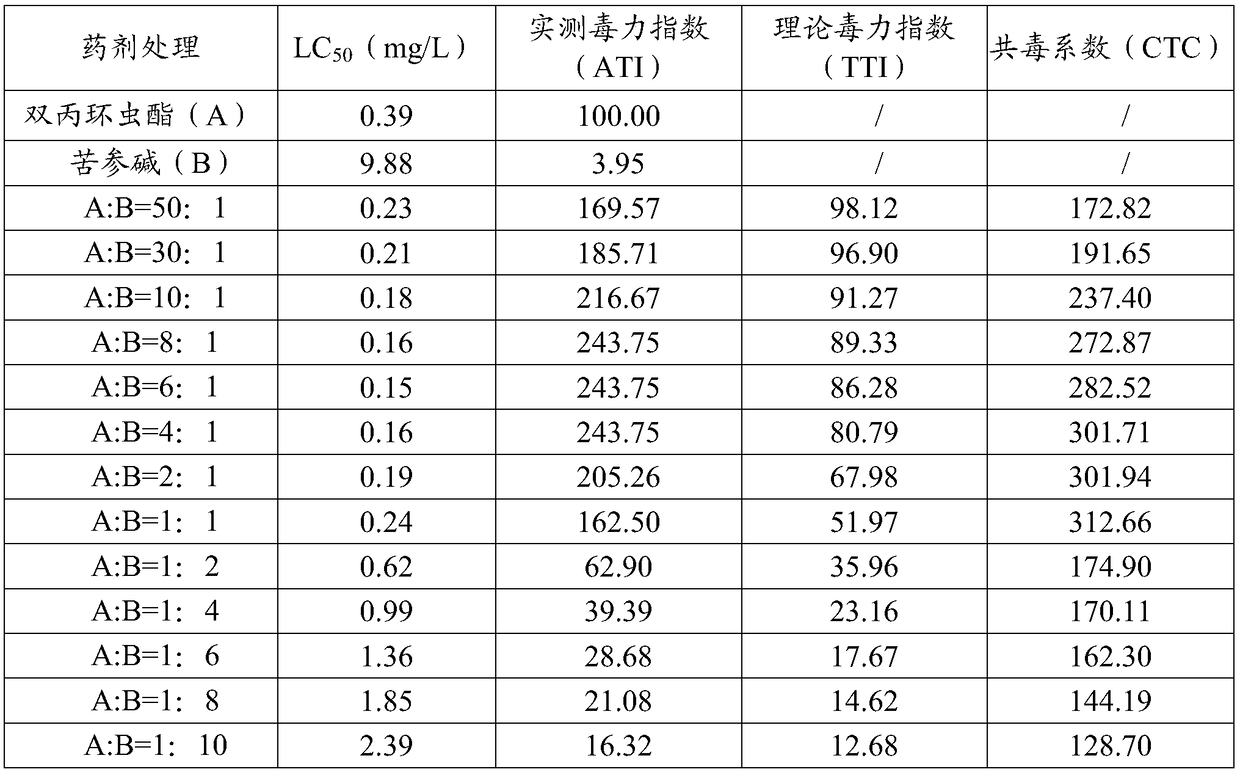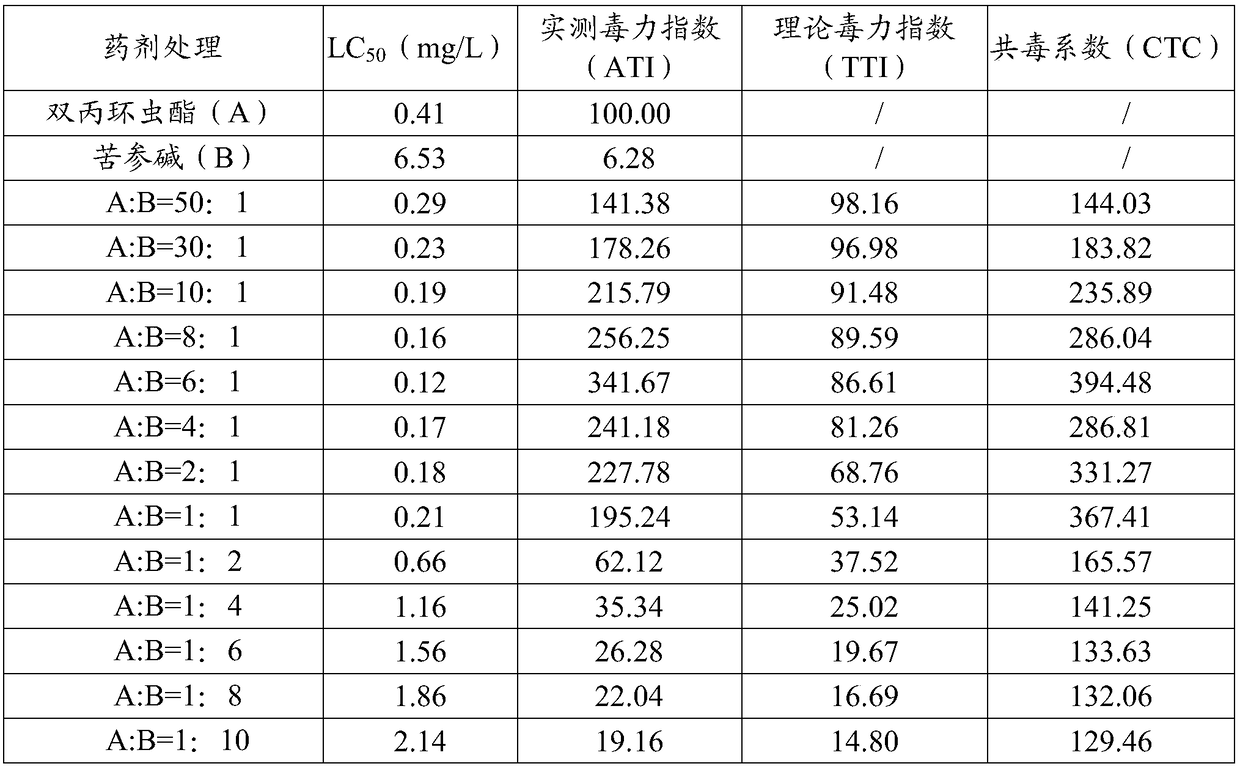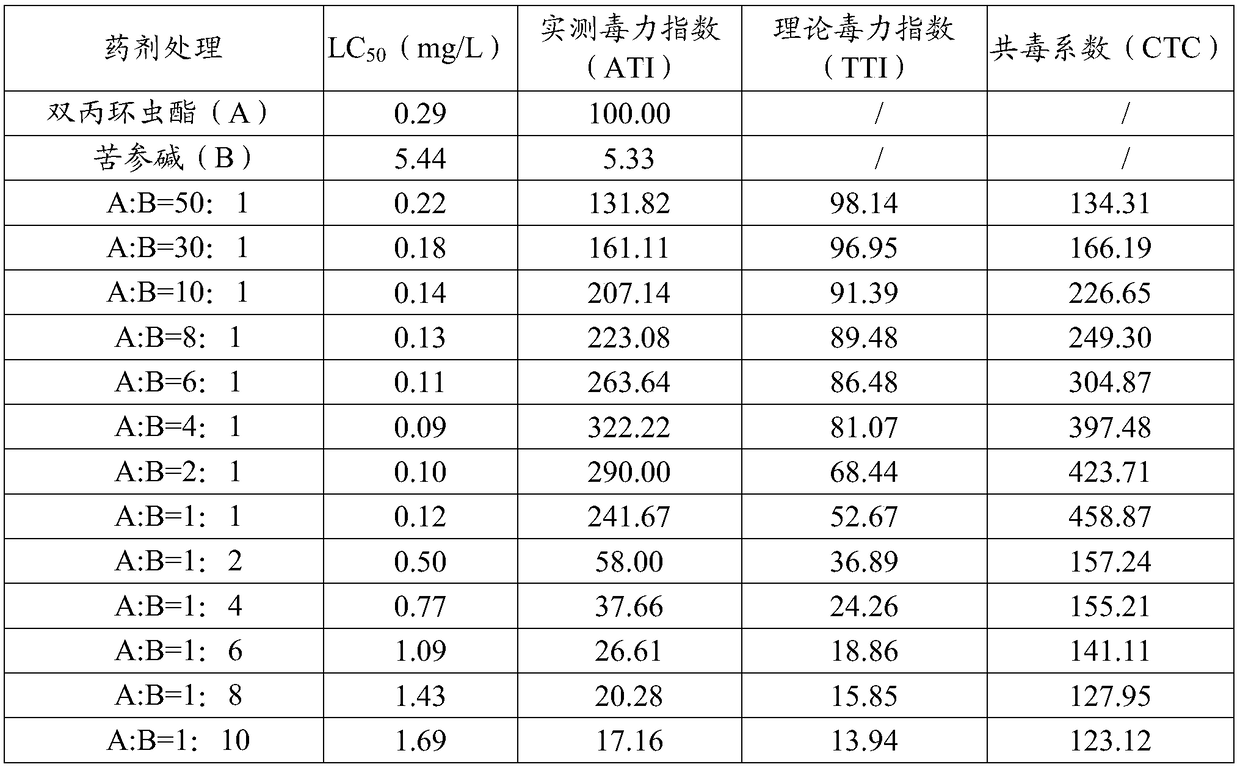A kind of synergistic insecticidal composition containing dipropacyclopyrene
An insecticidal composition, the technology of dipropetal, which is applied in the direction of insecticide, biocide, animal repellent, etc., can solve the problems that have not been reported in any reports, and achieve the reduction of the dosage and use cost in the field. The effect of site increase and drug efficacy improvement
- Summary
- Abstract
- Description
- Claims
- Application Information
AI Technical Summary
Problems solved by technology
Method used
Image
Examples
Embodiment 1
[0017] Bioassay Example 1: Indoor combined virulence test of the compound pair of diprofen and matrine on rice planthopper
[0018] Test object: Nilaparvata lugens (Stdl), the brown planthopper, artificially raised indoors for many generations.
[0019] Test method: The test method refers to the "People's Republic of China Agricultural Industry Standard NY / T1154.11-2008", using the rice stem soaking method. Pull out the robust rice plants at the end of tillering stage by rooting, wash them, and cut them into 15cm-long rooted rice stalks, 4 plants in groups, and dry them in the shade until there are no water marks on the surface. Soak the rice stems in the diluted medicament for 30 seconds. After they are taken out and air-dried, they are put into a petri dish with soaked absorbent cotton around the roots, and the mid-third instar nymphs are sucked into the petri dish, 25 per cup. Soak in clean water as a blank control, and repeat each concentration 4 times. After treatment, they ...
Embodiment 2
[0030] Bioassay Example 2: Indoor combined virulence determination test for thrips in combination of dipropiofen and matrine
[0031] Test object: Frankliniella occidentalis, the cucumber seedlings were artificially raised in an incubator for seven generations.
[0032] Test method: The test refers to the "People's Republic of China Agricultural Industry Standard NY / T 1154.14-2008" and uses the leaf immersion method to determine. Soak the prepared cabbage leaves (3㎝×4㎝) in the medicinal solution for 10 seconds, take it out and let it dry until there are no water marks on the surface, pick up the third instar nymphs of western flower thrips with a brush, and transfer the test insects Normally cultivate in a greenhouse at (25±1)°C, 14 / 10 (L / D), and a relative humidity of 70%. Each treatment was repeated 3 times, and each repeated 30 test insects.
[0033] The statistical analysis method is the same as that of Bioassay Example 1, and the virulence test results are shown in Table 2.
[...
Embodiment 3
[0037] Bioassay Example 3: Indoor Joint Toxicity Determination Test of Bipropacyclone and Matrine in a Compound Pair of Green Leafhopper
[0038] Test object: Empoasca pirisuga (Matumura), a cabbage raised indoor for eight generations.
[0039] Test method: The test refers to the "People's Republic of China Agricultural Industry Standard NY / T 1154.14-2008" and uses the leaf immersion method to determine. Soak the prepared cabbage leaves (3㎝×4㎝) in the medicinal solution for 10 seconds, take it out and let it dry until there are no water marks on the surface, use a writing brush to pick up the adult green leafhoppers of the same age and put them into the insects. In the box, transfer to (25±1)°C, 14 / 10 (L / D), and normal culture in a greenhouse with a relative humidity of 70%. Each treatment was repeated 3 times, and 50 test insects were repeated every time. Check the number of dead insects at 72h, calculate the mortality rate and the corrected mortality rate. If the control morta...
PUM
 Login to View More
Login to View More Abstract
Description
Claims
Application Information
 Login to View More
Login to View More - R&D
- Intellectual Property
- Life Sciences
- Materials
- Tech Scout
- Unparalleled Data Quality
- Higher Quality Content
- 60% Fewer Hallucinations
Browse by: Latest US Patents, China's latest patents, Technical Efficacy Thesaurus, Application Domain, Technology Topic, Popular Technical Reports.
© 2025 PatSnap. All rights reserved.Legal|Privacy policy|Modern Slavery Act Transparency Statement|Sitemap|About US| Contact US: help@patsnap.com



